ISSN ONLINE(2319-8753)PRINT(2347-6710)
ISSN ONLINE(2319-8753)PRINT(2347-6710)
Gorakshanath Abande1, M.F.A.R. Satarkar1, Mohan Thakre2, Dr.V.S. Kale2, Ganesh patil1
|
| Related article at Pubmed, Scholar Google |
Visit for more related articles at International Journal of Innovative Research in Science, Engineering and Technology
This paper presents simulation model of distance relay with STATCOM and simulation results for investigating the operation of Distance relay in a power system containing flexible alternating current transmission (FACTS) controller such as static synchronous compensator (STATCOM).when STATCOM is connected at the midpoint and fault is after STATCOM have great impact on distance relay tripping characteristics. The simulation results shows the impact of STATCOM on distance relay when STATCOM is connected at starting end, mid-point and at end side during phase to ground fault condition. In the presence of STATCOM, its controlling parameters as well as its installation location also affect the tripping characteristic. Here, simulate the Distance Relay and plot the zones and create fault in different zones and show the result with and without STATCOM. The simulation results are presented in relation to typical 300km, 400kv transmission system employing STATCOM.
Keywords |
| Distance relay, FACTS, power system protection, STATCOM. |
INTRODUCTION |
| In recent years, the security and reliability of power system has changed to an important issue. Meanwhile, distance protection is one of the security issues requires considerable attentions. Distance protection is based on the measurement of the impedance of lines [1] |
| Distance relays have been successfully used for many years as the most popular type of protection for transmission lines. The development ofelectromechanical and solid state relays with mhocharacteristics can be considered as an important factor. Zone 1 ofdistance relays is used to provide primary high speedprotection, to a significant portion of the transmissionline. Zone 2 is used to cover the rest of the protected lineand provide some backup for the remote end bus. Zone3 is the backup protection for all the lines connected tothe remote end bus. The implementation of distancerelays requires understanding of its operating principles, as well as the factors that affect the performance of thedevice under different abnormal conditions.Generally we may make the fault analysis and the test by the simulation software, and according to the actual system requirement, choose the suitable protective relay, but for reliability and security considerations, the massive simulations tests are usually undertaken. This is a quite numerous and diverse job; therefore, having a superior simulated environment is important [2]-[3]. |
| Updating of a transmission system by constructing new transmission lines becomes critical because of economic and environmental conditions. High efficiency in terms of better utilization of existing transmission lines, without affecting on the quality and reliability of electrical power apply has thus to be found via alternative means. And the alternative means are as -high power semiconductor technology and Flexible AC Transmission System (FACTS) technology has been developed to solve this problem. However, because of the added complexity due to the interaction of FACTS devices with the transmission system, the transients superimposed on the power frequency voltage and current waveforms particularly at the occurrence of fault can be significantly different from those systems not connected FACTS devices and it will result in rapidchanges in system parameters like line impedance and power angle. Therefore it is very important to study the impact of the FACTS devices on the traditional protection relay scheme such as distance protection relay [4]-[5]. |
| STATCOM is one of the most important and widely used FACTS devices. It is based on a voltage source convert and can inject an almost sinusoidal current with variable magnitude and in quadrature with the connecting line voltage .It is widely used at area to maintain the reactive power into the power connecting point voltage by injecting or absorbing system. Because of the presence of STATCOM devices in a fault loop, the voltage and current signals at relay point will be affected in both steady and transient state. This impact will affect the performance of distance relay. |
STATIC SYNCHRONOUS COMPENSATOR (STATCOM) |
| Now-a-days power systems have become very complex with interconnected long distance transmission lines. The interconnected Grids become unstable as the heavy loads vary dynamically in their magnitude and phase angle and hence power factor. Therefore, in order to meet increasing power demands, utilities must rely on power export/import arrangements through the existing transmission systems. The capacitor banks are used to improve power factor but having a number of disadvantages [6] |
| NEED OF FACTS DEVICES |
| The main advantages of using FACTS devices are |
| Better utilization of existing transmission system assets |
| Increased transmission system reliability and availability |
| Increased dynamic and transient grid stability and reduction of loop flows |
| Increased quality of supply for sensitive industries [7]. |
| STATCOM is one of the key FACTS Controllers. It can be based on a voltage sourced converter (VSC) or current-sourced converter (CSC). The voltage-sourced converters are most preferable device as compare to current sourced converter by considering overall cost and will be the basis for presentations of most converter-based FACTS Controllers. STATCOM can be designed to also act as an active filter to absorb sys-tem harmonics [8].The VSC connected in shunt with the ac system provides a multifunctional topology which can be used for up to three quite distinct purposes |
| Voltage regulation and compensation of reactive power |
| Correction of reactive power |
| Elimination of current harmonics [9]. |
| STATCOM is capable of generating and /or absorbing reactive power whose output can be varied so as to maintain control of specific parameters of electrical power system. On transmission level, Systems are normally balanced, but during fault condition system get disturbed. In this paper three level three phase IGBT type STATCOM is used.The controller input is an error signal obtained from the reference voltage and the rms value of the terminal voltage measured. Such error is processed by a PI controller the output is the angle δ which is provided to the PWM signal generator. |
DISTANCE RELAY |
| In the protection of transmission line, the use of distance relays has found to be the most feasible and effective as compared to the other type of protection such as over current relay. The over current relays are principally dependants on only one actuating quality which is current. There are some parameters in transmission line such as line resistance, source impedance, types of faults, fault location etc. which affects the current measured by relay. This leads to unsatisfactory performance of over current relay. On the other hand distance relay being actuated by two quantities, comparatively gives much better performance by taking care of all such factors. There are three types of distance relays namely reactance relay, impedance relay and mho relay. But performance of these relays gets affected by factors like power swing, arc resistance. The quadrilateral distance relay is quite better option for the protection of transmission line as it covers minimum area in R-X diagram and it is closer to ideal distance relay characteristic[10]When a short-circuit fault occurs on a transmission line, distance relays gives protection and trips the circuit breaker by disconnecting the faulty portion from the healthy section.[11]. |
| The setting of distance relays should ensure that the relay is not going to operate when not necessary and will operate, only when it’s necessary. Distance relays effectively measures the impedance between the relay location and the fault. If the resistance of the fault is low, the impedance is proportional to the distance from the relay to the fault. A distance relay is designed to only operate for faults occurring between the relay location and the selected reach point and remains stable for all faults outside this region or zone. |
| In this case the mho relay is taken and zone wise faults are creates and compares the results |
SIMULATION SCHEME |
| The fig.3 shows a typical simulation of the 400kv and 300km long transmission line. In addition, when a fault occurs on transmission lines, the voltage and current signals are severely distorted. These signals may contain decaying dc components, high frequency oscillation quantities, subsystem frequency transients, and etc. The higher frequency components can be eliminated using low pass anti-aliasing filters with appropriate cut-off frequency, but the anti-aliasing filters cannot remove decaying dc components and reject low frequency components. This makes the Phasor very difficult to be quickly estimated and affects the performance of digital relaying. Therefore, we usually use the mimic filter to remove the dc-offset components [12]. |
| Many filters have been proposed to eliminate the DC offset harmonics from the waveforms. A high pass filter with small cut-on frequency as compared to the Nyquist frequency is a required specification for the optimum design of the digital filter. |
| A digital filter based solution is proposed to remove the unwanted disturbances using digital filter design techniques. In addition, the required property of a measuring algorithm in protective relaying is to trace a given feature of signal (such as magnitude and phase) that may serve as an initial quantity for certain operating principles, which changes abruptly due to faults in a power system. [13] |
| Following steps are taken into consideration while simulating the distance relay: |
| Step 1: taking voltage and current signals from simulation of system under study which are in discrete form. |
| Step 2: Apply the filtering technique for those current and voltage signals to remove dc-offset components. Apply the same filtering technique for all the three phase current and voltage signals. |
| Step 3: Phasor estimation using DFT. |
| Step 4: Calculate the impedance values for each phase under fault conditions. |
| Step 5: Draw the impedance trajectory. |
| Step 6: Connect STATCOM |
| Step 7: Compares the results with and without STATCOM |
| From the above discussion, the MATLAB can easily finish all of algorithms for protective relays. With the advantage that SIMULINK can easily simulate power system faults, the design and the test of protective relays can be achieved with ease. Its major characteristic of integrating system fault simulation and protection relay algorithms in a software system can enhance the efficiency of protection relay test |
| STATCOM at starting end |
| When STATCOM connected at starting end the zone wise results with and without STATCOM are shown below |
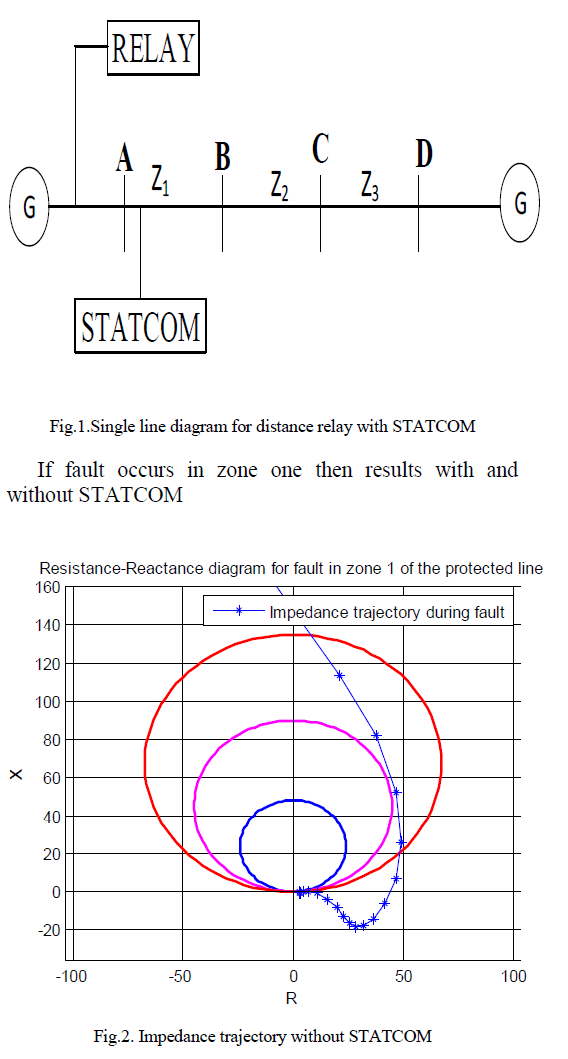 |
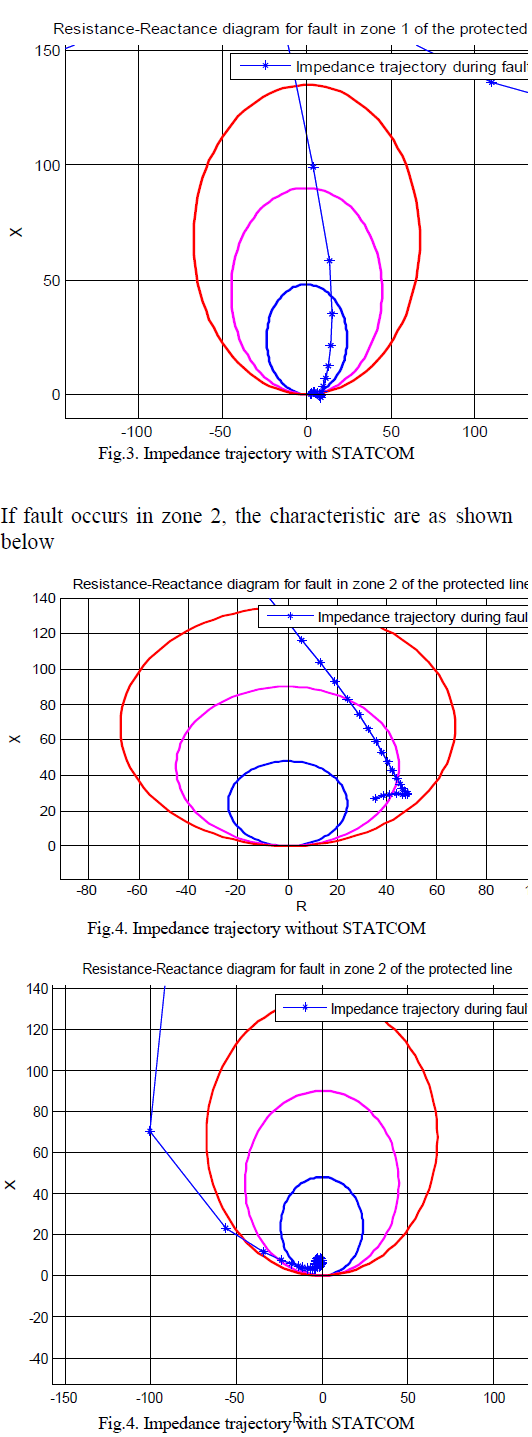 |
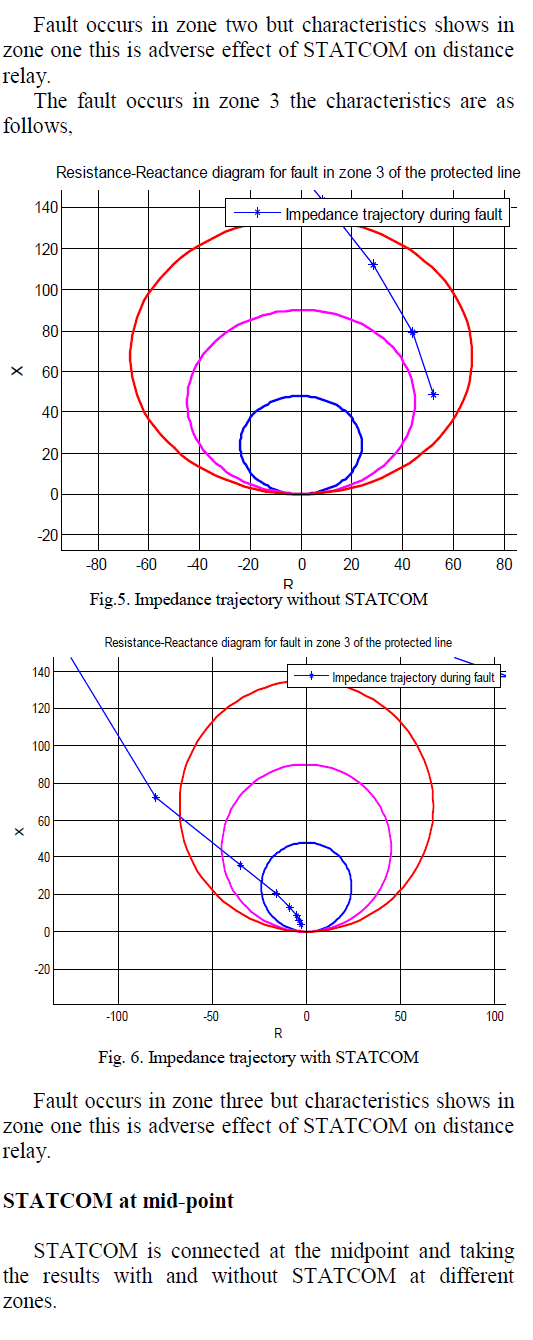 |
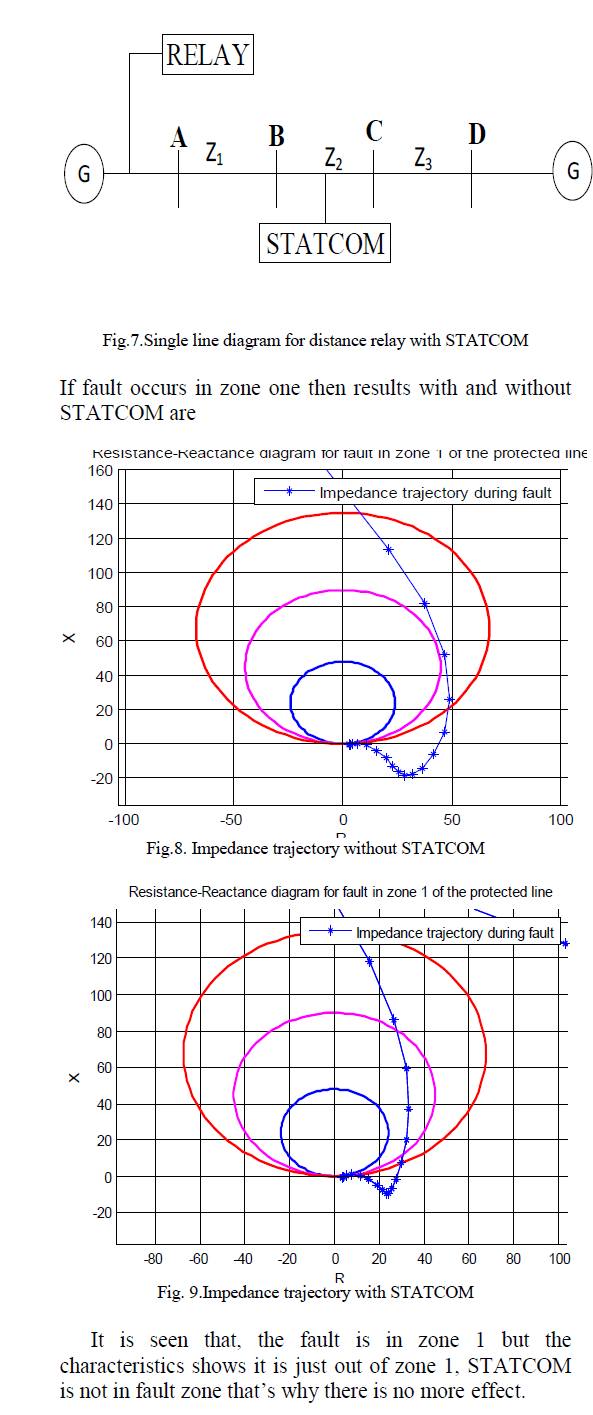 |
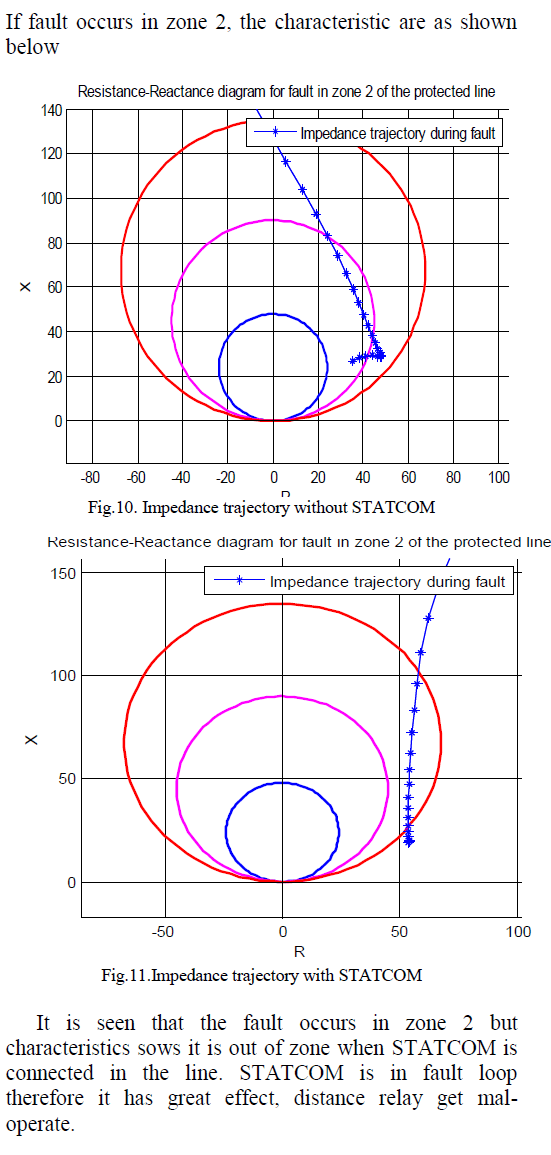 |
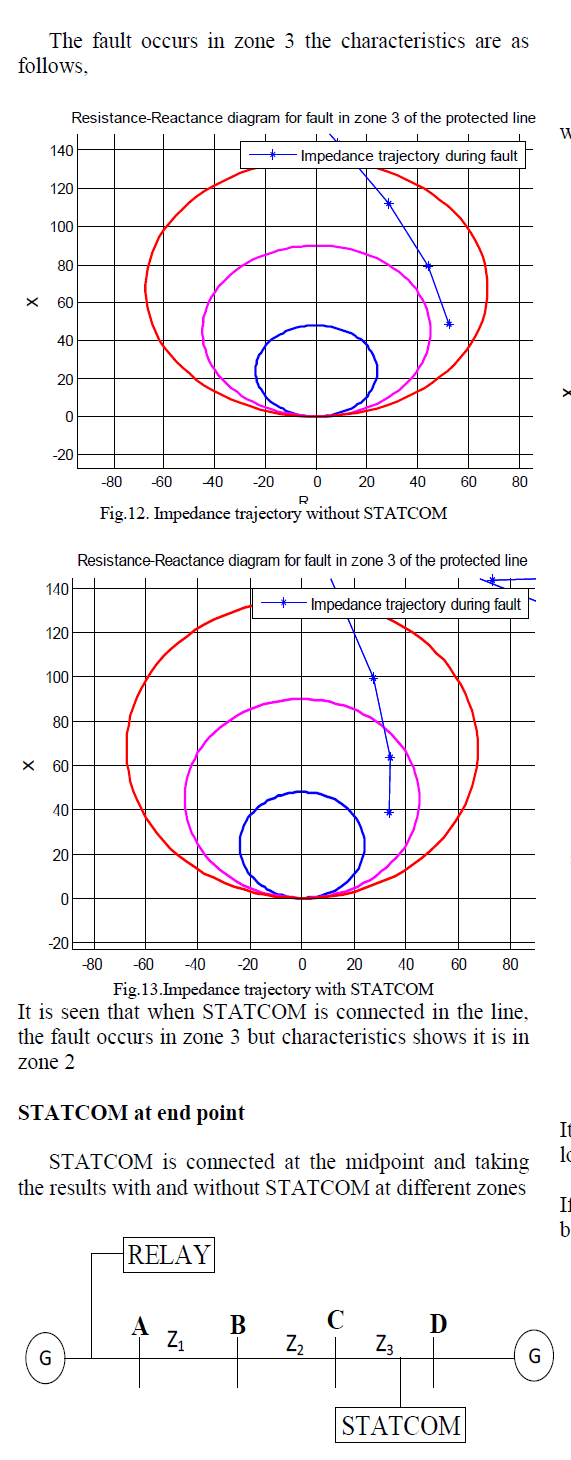 |
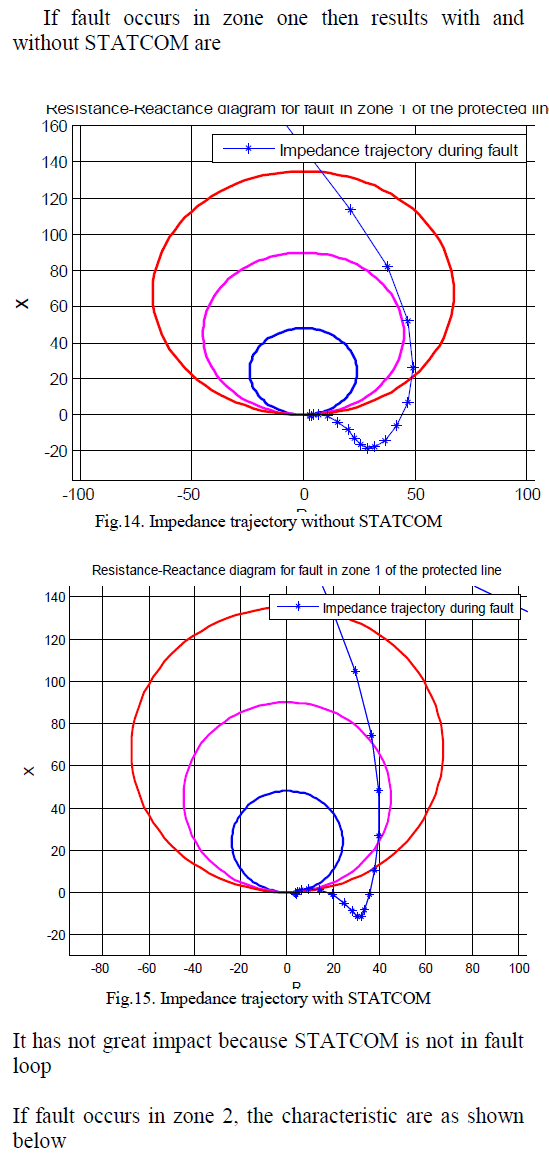 |
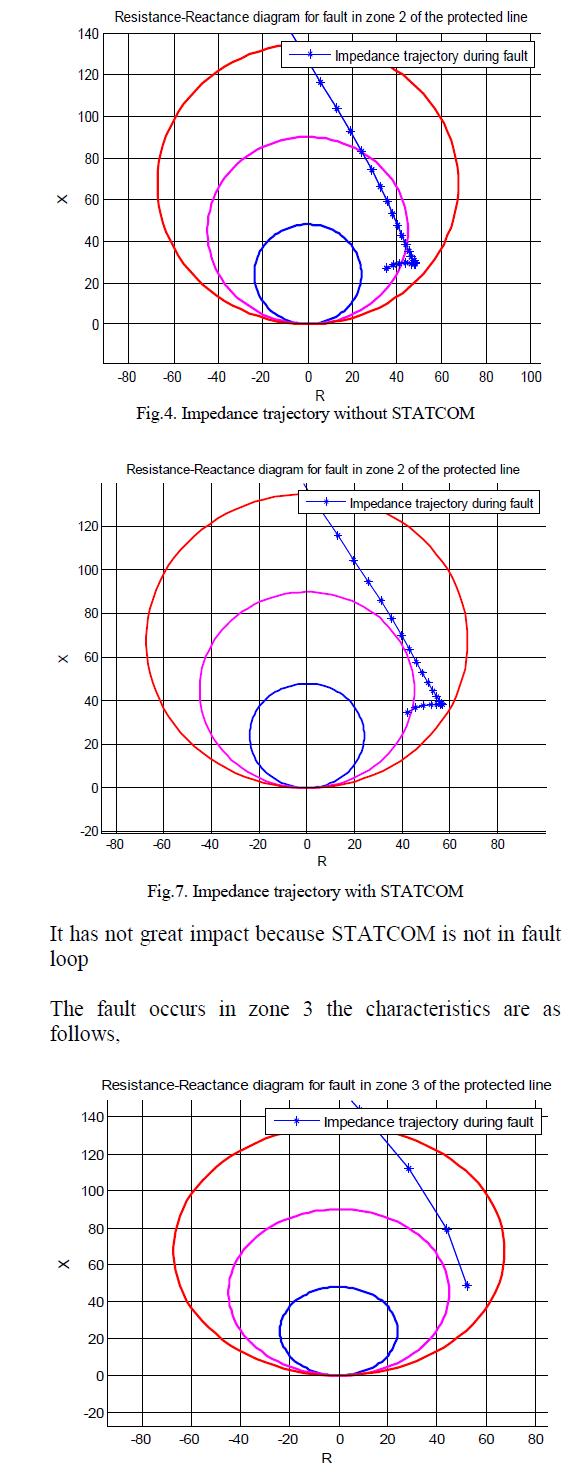 |
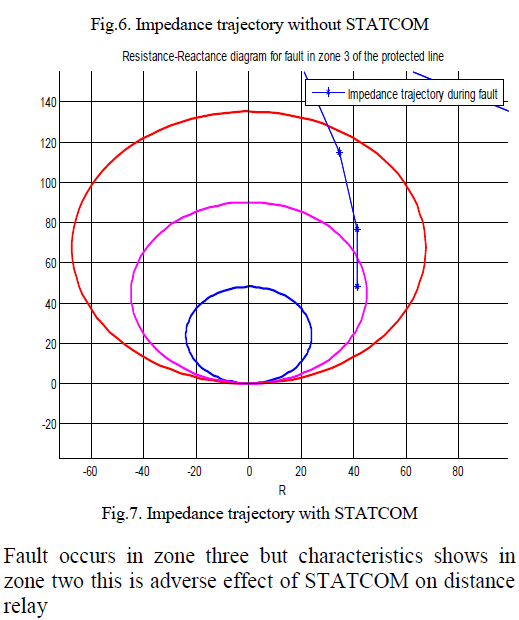 |
CONCLUSION |
| This paper present a detailed Simulation model of a transmission system of 400kv and 300km long having three zones and employing STATCOM for reactive power compensation. And plotted the mho characteristics. Fault is created in different zones and taking the zone wise results with and without statcom. When STATCOM is in fault loop then it has adverse effect on distance relay. Distance relay get mal-operate when STATCOM is in fault loop. |
References |
|